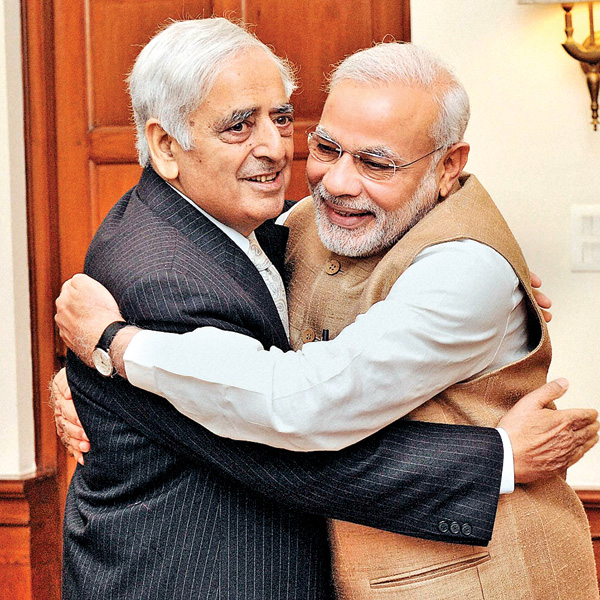Kashmir needs restoration of its centuries-old, composite society
and not clusters of imprisoned citizens acting as perennial sources of
friction

The idea of “composite townships” for
Kashmiri Pandits in the Valley has renewed tensions between the
communities rather than create an atmosphere conducive for their return.
Kashmir boasts a 5,000-year long history and one of the unique
attributes of the local people has been their tolerance and peaceful
communal living.
Some of the Vishwa Hindu Parishad ideologues recently observed that the Pandits had “owned” Kashmir for the past 5,000 years. It is true that Kashmiri Pandits (Brahmins) did constitute the ruling elite of Kashmir for its 5,000 year old history.
There is a written record, the only of its kind in the sub-continent, in the form of Kalhana’s Rajatarangni which in Sanskrit means the “River of Kings”. It details minutely the history of the Kings of Kashmir till twelfth century AD from the earliest times. The ruling Pandits comprising the upper caste Brahmin class constituted only 2% of the population.
The origin of Kashmiris is an interesting topic. The Neolithic dwelling pits and implements found at Burzohama and many other places in the Valley confirm the beginning of human life in Kashmir like the rest of the world.
According to Kalhana, the early dwellers of Kashmir were Nagas and Picasas. Then Aryans are supposed to have come from Central Asia and subdued the local Nagas and Pisacas. There are also theories about the coming of Israelites to Kashmir. After the destruction of the second temple, the twelve tribes of Israelites were dispersed all over the world. Kashmiris are supposed to be part of the missing twelfth tribe.
According to some legends, Jesus Christ and Moses are buried in Kashmir. There are many stories about early arrival of Jews in Kashmir. Interestingly, Kalhana mentions in Rajatarangni that the Kashmiris in earlier times were very restrictive and would not allow outsiders to come into the Valley.
The only exception was the Jews whom he calls “Maleech” (unclean or unholy) who were off and on allowed in. Some researchers have also observed many cultural and traditional similarities between the Kashmiris and Jews. Incidentally, Israeli tourists are fond of Kashmir Valley and according to some; they feel at home in Kashmir.
Religion wise, after the initial Naga worship, Kashmiris started with the Saivite Hinduism of Trika School of philosophy. This school believes in monotheism which has been one of the important factors in their mass conversion to Islam. The Saivite School of philosophy of Hinduism in Kashmir received much acclaim. It was studied at the famous Sharda University which became known all over the world as an important seat of learning and people from far and wide came here.
After Saivism, Buddhism also flourished here and the fourth Buddhist Council was held here. This unique conclave of Buddhist philosophers was responsible for changing the basic philosophy of Buddhism from the strict Hinayana School to the moderate Mahayana School. Subsequently, Saivism again gained ascendancy.
Finally, the advent of Islam through the spiritual preachers like Bul Bul Shah and Mir Sayed Ali Hamadani changed the whole scene. The entire population except the ruling Brahmins, the Pandits, converted to Islam peacefully. The Pandits virtually lost the Kingdom after the last non-Muslim (Buddhist) King Rin Cin Shah also embraced Islam.
Till that time the Pandits had been ruling Kashmir with the force of their swords but then on they took the “pen” in their hands and ruled over Kashmiris for almost 800 years. Thus they still continued to be the Kings (rulers) of Kashmir even after losing their physical hold on the government through the power of their pen. They became the ruling elite, the landlords and the money lenders and had the Kashmiri society in their strong grip. Nonetheless, the bonhomie between the Pandits and Muslims remained strong.
In 1947, Sheikh Abdullah through his unique legislation in the entire sub-continent called for giving the “land to the tiller” and the freezing of all debts. It resulted in the Pandits losing their rich estates, landholdings and money power. Yet they remained a harmonious part and important segment of the Kashmiri society. However, their mass migration in the turmoil of 1990 deprived them of all their power and they truly lost the 5,000-year old Kingdom.
No wonder most of the prominent Kashmiri Pandits including the stalwart Pandit Jawaharlal Nehru, the first prime minister of India, pined for the lost Kingdom. They refused to accept the ground reality that Kashmir, now a Muslim majority state, could never become a Hindu Kingdom again.
Majority of Muslims in Kashmir never wanted Kashmir to be an Islamic state but as an independent, sovereign republic where all religions are respected equally. The Pandits instead of joining their Muslim brethren most of whom may have the same blood flowing through their veins and with the same basic DNA have been trying to reverse the history. They are now being used by Hindutva chauvinists with their inherent hatred for Muslims to settle the scores with them.
One cannot, however, reverse the march of history. Civilizations come and go and the world moves on. Panun Kashmir, composite townships and the artificially carved settlements cannot bring back the ancient Hindu Kingdom of Kashmir.
